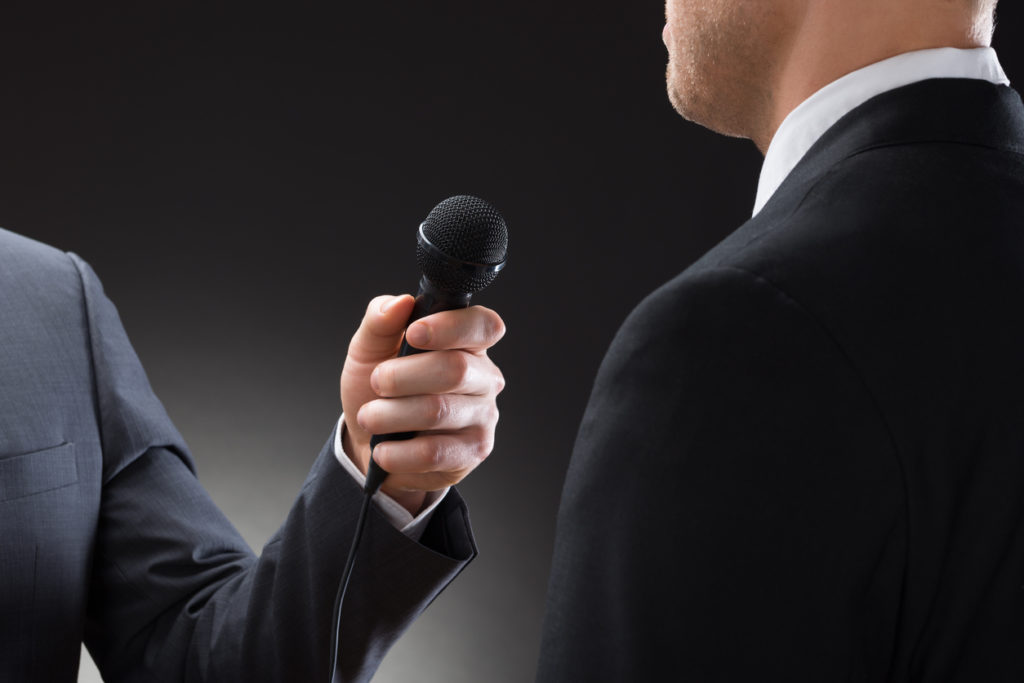Are Media Trainers The Enemy?
A few days ago, I noticed that a journalist from Auckland, New Zealand had sent out this tweet:
“A fascinating media training blog – mrmediatraining.com #knowthyenemy”
First, thank you. I’m glad you like this blog!
Second, how cool that people are reading this blog in New Zealand!
Third, are we really the enemy? If you missed it, the journalist used the hash tag #knowthyenemy. I’m pretty sure he didn’t mean that literally (at least I hope he didn’t). But I’ve heard the same sentiment numerous times before, that media trainers are the enemies that somehow prevent honest dialogue with journalists and subvert democracy.
Today’s post will address that question directly: are media trainers the enemy?
One of the biggest misconceptions about media trainers is that we’re Machiavellian string pullers who tell people what to say and how to say it. But that approach rarely works, since communication is rarely effective (at least in the long-term) unless it’s rooted in authenticity. The approach we recommend can’t be top-down – rather, we have to build an approach based on the views and positive traits the spokesperson already holds.
The vast majority of our training sessions are spent on subjects that help journalists. Among other things, spokespersons who have been media trained know how to:
- Deliver a clear and concise message in the short timeframe television allows
- Eliminate jargon that makes their messages undecipherable to a general audience
- Communicate in a variety of different formats, including radio, television, and podcasts
- Look in the right place, eliminate distracting vocal tics, and appear more confident
I’d argue that those things are good for both the media and the public.
Okay, But That’s Kind of an Incomplete Definition, Isn’t It?
Yes. In addition to the rather straightforward items listed above, media trainers also help spokespersons frame their messages in the most favorable light possible. That’s where people begin to get suspicious. But assuming the media trainer is an ethical practitioner, those suspicions are usually unfounded.
I think of it this way: all of us have different sides to our personalities, and we show them at different times. For example:
- A young woman might act differently during a job interview than she would on a Friday night while drinking with her friends.
- A middle-aged man man probably speaks to his childhood friends with saltier language than he would his children or parents.
- Business professionals almost certainly talk to their clients differently than their spouses.
In all of those situations, we accept that people present incomplete versions of themselves. The same dynamic applies in media training workshops, during which we help trainees present the most appealing version of themselves. Sure, they’re going to clean up their roughest edges and present their most likeable selves. But those versions of themselves have to be a genuine part of who they truly are in order to be effective.
Come On. Shouldn’t People Just Be Themselves?
In an ideal world, yes. But…
If a spokesperson says something just a little bit “off” – something I call the seven-second stray – the media will play the clip on an endless loop. CNN will show the clip twice per hour, radio talk show hosts will rail against it, and Jon Stewart will make fun of it. As a result, that stray could diminish the reputations of business leaders, kill the candidacies of political candidates, and destroy the careers of entertainers.
Given the state of today’s “gotcha” sound bite media culture, wouldn’t leaders be irresponsible if they didn’t learn how to avoid those types of situations? Wouldn’t they be irresponsible if they didn’t learn how to advocate on behalf of their brands as effectively as possible?
Sure, we occasionally swim in murky waters along with some tough ethical questions. Perhaps a spokesperson doesn’t agree with the official company party line. Maybe a political candidate knows he’s probably going to lose, but can’t say so for fear of diminishing voter turnout. Or maybe an executive fears that a product isn’t likely to be the hit he thought it was going to be, but doesn’t want to dampen the product launch by saying so. But those moral dilemmas are going to exist with or without media trainers – and if we do our jobs well, we can help them navigate those situations in a manner that will allow them to retain their integrity and preserve their reputations.
So, going back to the original question: are media trainers the “enemy?” I’ll leave that answer to you. Please leave your thoughts in the comments sections below.





As the author of the #knowthyenemy tweet, I feel obliged to respond!
This does raise some interesting points about the relationship between public relations consultants/spokespeople and journalists.
New Zealand’s news industry is small, but extremely competitive. And like many in the US, Kiwi newsrooms have shrunk. Reporter numbers have fallen with budgets and salaries, and experience (I’ve heard anecdotal evidence the average age of the Kiwi newsroom is now 25).
The upshot of all this is a growing reliance on ready-made copy that’s pouring through an inexperienced under-pressure filter called the young journalist.
Journalist Nicky Hager describes an industry where printing or re-writing press releases has become commonplace:
“Recently I was helping take a journalist training session and one of the chief reporters there said this is so common that he has introduced a rule of printing out press releases before assigning them to reporters because then they at least cannot just cut and paste directly from the press release. His modest goal, slightly rewritten press releases!” (http://bit.ly/z6t1Mf)
He goes on to describe how the PR industry is far better resourced and more focused than the news industry is. This is a big issue for Kiwi newsrooms who are under intense pressure to produce eye-catching copy fast.
My friend Sarah Robson wrote about the relationship between Government public relations officers and journalists and the need for them to get along (http://bit.ly/ypkQMr). We should have a solid working relationship with communications staff, because they’re not the enemy. We’re partners.
I get the feeling the relationship has changed. There is an expectation here that press releases will “run” unchanged and unexamined. That doesn’t do coms staff or journalists any favours at all.
If we’re complicit in accepting PR at face value, then we simply aren’t doing our job properly. And that’s regardless of how tight our deadline is, or how easy it is to hit ctrl-c, ctrl-v.
Michael,
Thank you for the inspiration for this story and for the thoughtful comment!
Things are quite as grim here in the U.S. yet, but it’s moving in that direction. In fact, close to a decade ago, I wrote a press release about ecotourism that the Associated Press ran almost verbatim. As a former journalist, it was horrifying for me to see that, and it made me (even more) skeptical about taking any individual press report at face value.
When we discuss working with reporters in our media training workshops, we rarely recommend writing the releases for reporters, but rather providing them with all of the raw information (content, photos, video, etc) they need to make their lives easier. Companies can use their own websites and social media platforms to disseminate whatever other information they want to verbatim.
Thanks again, and I hope to visit your beautiful country at some point soon!
Brad
Brad, I enjoyed this thoughtful exchange. Many journalists I know like interviewing a well-trained spokesperson. They get a good soundbite and the story is often much better when spokespeople are articulate and media-savvy. As Michael says, good journalists know how to bring many voices to a story although it sounds more difficult down under for reasons unclear to me.